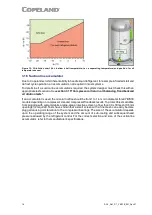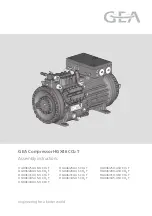
10
AGL_Ref_ST_YBK1E_EN_Rev01
3.4
Pressure safety controls
3.4.1 High-pressure protection
Applicable regulations and standards, for example EN 378-2, shall be followed to apply appropriate
control and ensure that the pressure never exceeds the maximum limit.
High-pressure protection is required to stop the compressor operating outside the allowable pressure
limits. The high-pressure control must be installed correctly, which means that no service valve is
allowed between the compressor and the pressure protection.
The high-pressure cut-out setting shall be determined according to the applicable standard, the type
of system, the refrigerant and the maximum allowable pressure PS.
3.4.2 Low-pressure protection
CAUTION
Operation outside the application envelope! Compressor breakdown!
A
low-pressure protection shall be f itted in the suction line to stop the
compressor when it operates outside the envelope limits.
Applicable regulations and standards shall be followed to apply appropriate safety control and ensure
that the pressure is always above the required minimum limit.
Low-pressure protection is required to stop the compressor operating outside the allowable envelope
limits. The low-pressure control must be installed correctly into the suction line, which means that no
service valve is allowed between the compressor and the pressure protection.
The minimum cut-out setting shall be determined according to the ref rigerant and the allowed
operation envelope
– see Select software at
www.climate.emerson.com/en-gb/tools-resources
.
3.5
Protection of A2L refrigerant systems operating below atmospheric pressure
WARNING
Operation below ambient pressure! Fire hazard!
During operation below
atmospheric pressure, a f lammable mixture can f orm inside the system.
Ensure system tightness to prevent any ingress of air.
Special requirements for safety and tightness apply to YB*K1E compressor systems that are to be
operated below atmospheric pressure. The f ollowing precautions must be observed:
▪
Check all the critical points on the system and piping connections; tightness has to be ensured
also at very low pressure.
▪
Minimum absolute working pressure: 0.5 bar.
▪
The installation of mechanical high-pressure and low-pressure cut-outs is mandatory. For
systems provided with a service shut-off valve on the discharge side of the compressor, only a
mechanical pressure cut-out shall be used. Electronic pressure limiters, which c ould cause
delayed sensor response, are not allowed.
▪
The high- and low-pressure cut-outs must be installed correctly on the discharge and suction
lines, which means that no service valve is allowed between the compressor and the pressure
protection (refer to EN 378 or ISO 5149).
▪
A discharge temperature control is mandatory to stop the compressor when the maximum
discharge temperature is exceeded
– see
section 3.7 "Discharge gas temperature
.
▪
Additional warning notices shall be af fixed to any system equipped with shut -off valves. The
warnings must contain instructions to open the shut-off valves completely af ter each repair or
maintenance work. The compressors may only be energized when the saf ety measures (high-
and low-pressure cut-outs and discharge temperature cut-out) have been checked and verified
to be operational.
NOTE: If any of the above points cannot be met, the compressors must not be operated below
atmospheric pressure!
















































